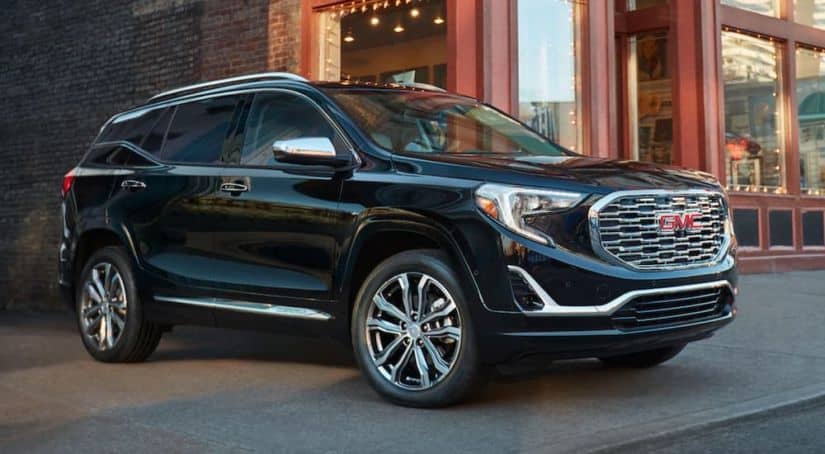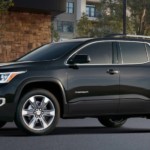Standing out in the SUV market can be a massive uphill battle. There are so many competitors to contend with, and a lot of automakers are doing a lot of things right. With so many players crowding a single area of the auto world, it can be easy to get lost in the noise, especially when particularly standout models capture all of the limelight. That said, every now and again, there are underdogs out there that deserve their own individual appreciation. The 2020 Honda CR-V is often touted as the world’s favorite SUV; however, low-key competitors like the GMC Terrain give the current king of the hill a run for their money. While we could roll over and believe in the status quo, that being that the 2020 Honda CR-V is the superior SUV, we believe that the GMC Terrain is deserving of focused attention. So, to even the stakes, we’re pitting the 2020 GMC Terrain vs 2020 Honda CR-V in an SUV showdown.
Looks and Styling Matter
At first glance, separating the difference between the Honda CR-V and the GMC Terrain can seem like quite a tall order. Both of these SUVs are on the bulkier side, and they sport a styling that really runs the risk of looking like a minivan. However, where the GMC Terrain wins out over the Honda CR-V is that the Honda CR-V really looks like a minivan. If you give the GMC Terrain a serious inspection, you’ll find a lot of characteristics that seem to be plucked directly from larger models in the GMC family lineup. From the front grille to the decently high ground clearance, and boxier design, you have an SUV that may not stand out in a field of other SUVs, but certainly offers a better appearance than its main competitor.

While looks matter, they aren’t everything, and when it comes right down to it, pricing and configuration options can make or break any SUV. The Honda CR-V opens up to drivers at an MSRP of $25,050, with four trims including the LX, EX, EX-L, and Touring. The GMC Terrain is a little more fleshed out by comparison but is also a little more expensive. While you’ll have to bite the bullet on a higher MSRP of $28,400, you will get to take advantage of the SL, SLE, SLT, or Denali trim options. While we could compare these two SUVs based on outward appearances and trim options alone, that wouldn’t be a fair match up for either vehicle. So, as to be expected of any good SUV review, we’ll delve into the mechanics packed behind each vehicle and determine which is the better performer.
What to Expect in Performance
We should mention that neither the Honda CR-V or the GMC Terrain are top performers. You won’t get hair-raising engine power, or off-road prowess by either of these SUVs, however, what you will get is a dependable driving experience through and through. That said, the new line of Honda CR-Vs have something that the GMC Terrain does not, a hybrid powertrain option. While hybrid powertrains tend to be more expensive, and somewhat unruly when it comes to repair and maintenance, Honda’s introduction of a hybrid-line puts it in another level above the GMC Terrain.
With a hybrid option, the Honda CR-V joins a growing crowd of SUVs that trend further and further towards fuel efficiency. While Honda’s introduction of a hybrid powertrain does deserve particular attention, we won’t use it to compare to the GMC Terrain, as the GMC option cannot compete in this area. But just know, the lack of a hybrid powertrain puts the GMC Terrain a step below the Honda CR-V in terms of options and fuel economy.
So, when it comes to performance, determining which SUV is superior, all comes down to what you’re looking for in an engine. The GMC Terrain offers a pretty solid base engine. The 1.5-liter Turbo 4-cylinder engine that you’ll find in base models is rated for 170 horsepower and 203 lb-ft worth of torque, which is pretty impressive. With that extra boost to torque, you’ll also get a 9-speed automatic transmission and front-wheel drive with the option of upgrading to all-wheel drive. This base powertrain gets up to speed without a huff or hesitation, which is nice considering the overall size of the engine. In the past, the GMC Terrain offered a turbodiesel option; however, for 2020, GMC has scrapped this third variant. Instead, the other option you’ll get is a 2.0-liter Turbo 4-cylinder engine that earns 252 horsepower and 260 lb-ft of torque, that same 9-speed automatic transmission, and the ability to haul up to 3,500 pounds without too much effort. So, as you can tell, the GMC Terrain isn’t necessarily a powerhouse, but it isn’t a small-fry either and can hold its own when put to task.
The engine in the Honda CR-V is good, but it is far from great, and besides the hybrid option, it’s the only powertrain you’ll get. That single engine option is a 1.5-liter turbocharged four-cylinder that churns out 190 horsepower and 179 lb-ft worth of torque, with the assistance of a CVT. The Honda CR-V can also be piloted with front-wheel drive or four, however, in terms of dynamic performance, that is where things end for the Honda CR-V. So while Honda gets a point for their introduction of a hybrid powertrain, it doesn’t get off the hook for its pretty underpowered standard engine.

Beyond Just Performance
While performance and engine build matter, these aren’t the only two points of value for both these vehicles. Both SUVs offer a considerable amount of comfort and are pretty neck and neck when it comes to spacing. The GMC Terrain, for instance, offers 39.7 inches of legroom for rear passengers, while the Honda CR-V is .3 inches ahead by offering 40 inches of rear legroom. Although, if you’re hoping to haul plenty of cargo, the Honda CR-V is a real winner with its startling 75.8 cubic feet of cargo space. The Honda CR-V, on the other hand, commits about 63.3 cubic feet to cargo space, which is great, but still several paces behind the Honda CR-V.
What’s really divisive between these two SUVs is the various technology features packed inside each model. For instance, the Honda CR-V does offer a considerable safety package, but it lacks much in the way of infotainment and convenience. The base model Honda CR-V does get a 5.0-inch infotainment screen, but it isn’t touch-activated, which feels rather archaic. You will get to enjoy some great features, and decent cloth upholstery, but these are small luxuries compared to the lack of infotainment technology.
The GMC Terrain, on the other hand, is the best of both worlds. The base model SL comes off of the factory floor at no extra cost with cloth seats, active noise cancellation, keyless ignition, two USB charging ports, a sweeping variety of active safety features, and a 7.0-inch infotainment touchscreen that is, yes, Apple CarPlay and Android Auto compatible. So while the Honda CR-V may tout a hybrid option and a decent tech package, you’ll have to pay a considerable amount of cash to compete with the GMC Terrain.
While we do favor the GMC Terrain as the superior SUV, we believe that you shouldn’t make a purchase based on our opinion alone. If you want to fully understand the differences between the Honda CR-V and the GMC Terrain, we highly recommend that you pay your local dealerships a visit and take them both out for a spin.



